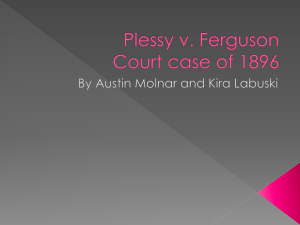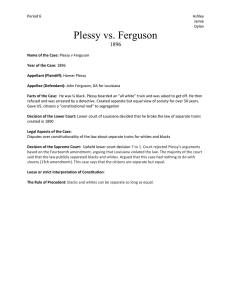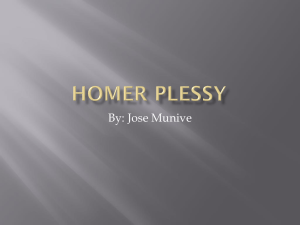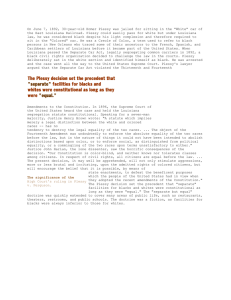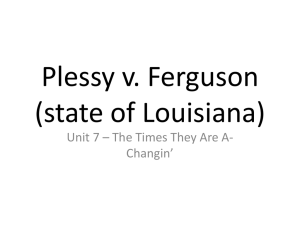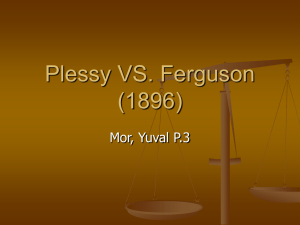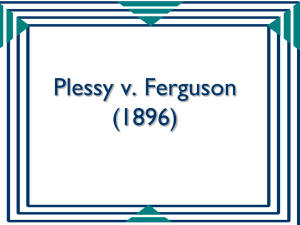Plessy v. Ferguson.doc
advertisement
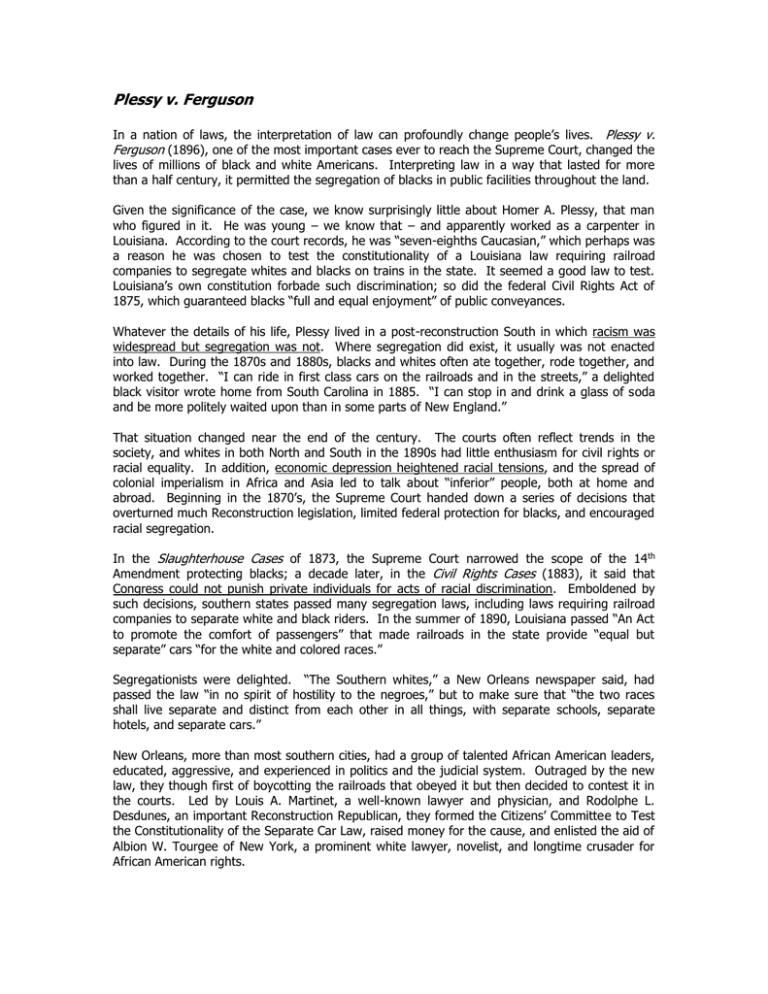
Plessy v. Ferguson In a nation of laws, the interpretation of law can profoundly change people’s lives. Plessy v. Ferguson (1896), one of the most important cases ever to reach the Supreme Court, changed the lives of millions of black and white Americans. Interpreting law in a way that lasted for more than a half century, it permitted the segregation of blacks in public facilities throughout the land. Given the significance of the case, we know surprisingly little about Homer A. Plessy, that man who figured in it. He was young – we know that – and apparently worked as a carpenter in Louisiana. According to the court records, he was “seven-eighths Caucasian,” which perhaps was a reason he was chosen to test the constitutionality of a Louisiana law requiring railroad companies to segregate whites and blacks on trains in the state. It seemed a good law to test. Louisiana’s own constitution forbade such discrimination; so did the federal Civil Rights Act of 1875, which guaranteed blacks “full and equal enjoyment” of public conveyances. Whatever the details of his life, Plessy lived in a post-reconstruction South in which racism was widespread but segregation was not. Where segregation did exist, it usually was not enacted into law. During the 1870s and 1880s, blacks and whites often ate together, rode together, and worked together. “I can ride in first class cars on the railroads and in the streets,” a delighted black visitor wrote home from South Carolina in 1885. “I can stop in and drink a glass of soda and be more politely waited upon than in some parts of New England.” That situation changed near the end of the century. The courts often reflect trends in the society, and whites in both North and South in the 1890s had little enthusiasm for civil rights or racial equality. In addition, economic depression heightened racial tensions, and the spread of colonial imperialism in Africa and Asia led to talk about “inferior” people, both at home and abroad. Beginning in the 1870’s, the Supreme Court handed down a series of decisions that overturned much Reconstruction legislation, limited federal protection for blacks, and encouraged racial segregation. In the Slaughterhouse Cases of 1873, the Supreme Court narrowed the scope of the 14 th Amendment protecting blacks; a decade later, in the Civil Rights Cases (1883), it said that Congress could not punish private individuals for acts of racial discrimination. Emboldened by such decisions, southern states passed many segregation laws, including laws requiring railroad companies to separate white and black riders. In the summer of 1890, Louisiana passed “An Act to promote the comfort of passengers” that made railroads in the state provide “equal but separate” cars “for the white and colored races.” Segregationists were delighted. “The Southern whites,” a New Orleans newspaper said, had passed the law “in no spirit of hostility to the negroes,” but to make sure that “the two races shall live separate and distinct from each other in all things, with separate schools, separate hotels, and separate cars.” New Orleans, more than most southern cities, had a group of talented African American leaders, educated, aggressive, and experienced in politics and the judicial system. Outraged by the new law, they though first of boycotting the railroads that obeyed it but then decided to contest it in the courts. Led by Louis A. Martinet, a well-known lawyer and physician, and Rodolphe L. Desdunes, an important Reconstruction Republican, they formed the Citizens’ Committee to Test the Constitutionality of the Separate Car Law, raised money for the cause, and enlisted the aid of Albion W. Tourgee of New York, a prominent white lawyer, novelist, and longtime crusader for African American rights. Tourgee did not hesitate to join in the fight, for which he charged no fee. “Submission to such outrages,” he angrily wrote his New Orleans friends, tends “only to their multiplication and exaggeration. It is by constant resistance to oppression that the race must ultimately win equality of right.” As a first step, Citizens’ Committee members went to various railroad officials to ask for aid in establishing a case that could test the law. Disliking the cost of the extra cars the law forced them to buy, the officials were sympathetic but reluctant. One railroad already refused to enforce the law; officials on two other railroads said it was “a bad and mean one; they would like to get rid of it,” but were afraid of public opinion. At last, the East Louisiana Railway agreed to help. And so on June 7, 1892, to test the law, Homer A. Plessy boarded an East Louisiana Railway train in New Orleans for the 30-mile trip to Covington. He took a seat in the car reserved for whites, refused to move when a conductor asked him to, and was arrested by a detective who was standing by for the occasion. John H. Ferguson, a local judge, ruled against Plessy’s argument that the law violated his rights, and Plessy appealed to the State Supreme Court, arguing that the law violated the “equal protection” clause of the 14th amendment to the Constitution. That Court, too, promptly ruled against him. Delighted, Louisiana segregationists hoped, as one of their newspapers said, that the two decisions would knock some sense into “the silly negroes who are trying to fight this law. The sooner they drop their so-called ‘crusade’ against the ‘Jim Crow Car,’ and stop wasting their money in combating so well-established a principle – the right to separate the races in cars and elsewhere – the better for them.” It took three more years before the United States Supreme Court heard the case. Tourgee himself was pleased with the delay, hoping that time might improve racial feelings in the country and bring popular support to his cause. Those hopes did not bear out, nor did his arguments before the Court. In an unusual approach, Tourgee began by arguing that Homer A. Plessy, who was light-skinned in color, had been deprived of property without due process of law, contrary to the 14 th Amendment. Able to pass for white, he had been identified by the railroad conductor as black. He had been robbed, therefore, of his “property,” Tourgee said, the sense of being white, and thus barred from association with white people, who in the United States controlled the avenues to advancement. “Probably most white persons if given a choice,” Tourgee argued, “would prefer death to life in the United States as colored persons. Under these conditions, is it possible to conclude that the reputation of being white is not property? Indeed, is it not the most valuable sort of property, being the master-key that unlocks the golden door of opportunity? The remainder of Tourgee’s brief was straightforward, stressing the incompatibility of the separate car law with the intent of the 13th and 14th Amendments, the inequities it fostered, and its basis in claims of white superiority. Unless the Court stopped it now, enforced segregation would soon spread everywhere through life. “Why may [a law] not require all red-headed people to ride in a separate car? Why not require all colored people to walk on one side of the street and the whites on the other? Why not houses of different color, or clothes, or carriages? Laws might make blacks and whites (or Protestants and Catholics, natives and foreign-born, or anyone else, for that matter) sit on the opposite side of a court room or use different playgrounds. Deciding the case was simple, Tourgee concluded: suppose you, the members of the Court, were suddenly ordered into a Jim Crow car of your own. “What humiliation, what rage would then fill the judicial mind?” Finally, on May 18, 1896, the Court handed down its decision in Plessy v. Ferguson. By a vote of 7 to 1, it decided against Plessy. Upholding the doctrine of “separate but equal,” it held that the Louisiana law did not violate Plessy’s rights. It did not violate them, the Court said, because the law was “reasonable;” it had been passed “with reference to the established usages, customs and traditions of the people. It was precisely those usages and customs – race prejudice, in short – that Tourgee had argued against. They were contrary to the Reconstruction amendments to the Constitution, he had argued, but the majority of the Court would have none of it. The authors of those amendments, they said, could not have meant to do away with racial distinctions or institute social equality; that simply could not be done. Laws did not create race prejudice, and they could not change it. Enforced segregation did not label anyone as inferior. “We consider,” the Court said, “the underlying fallacy of the plaintiff’s argument to consist in the assumption that the enforced separation of the two races stamps the colored race with a badge of inferiority. If this be so, it is not by reason of anything found in the act, but solely because the colored race chooses to put that construction upon it.” There was a single dissenter in the case, Justice John Marshall Harlan of Kentucky, and there was some irony in that, and a measure of the nation’s spreading racism as well. Justice Henry Billings Brown, a son of Massachusetts and Michigan, had written the opinion for the majority. Harlan, on the other hand, was not only from the South, he had once owned slaves. But accepting the changed requirements of the Reconstruction amendments, he became the “Great Dissenter” in a Court – and a country – fast fleeing it important responsibilities. Dissenting in Plessy, he scoffed at the majority’s reasoning. The Louisiana law, he said was clearly prejudicial, designed to keep blacks from railroad cars occupied by whites, and as such was in clear conflict with both the 13th and 14th amendments. It was a “badge of servitude,” inconsistent with “the equality before the law established by the Constitution. It cannot be justified upon any legal grounds.” “Our Constitution is color-blind, and neither knows nor tolerates classes among citizens. In respect of civil rights, all citizens are equal before the law. The humblest is the peer of the most powerful. The law regards man as man, and takes no account of his surroundings or of his color when his civil rights as guaranteed by the supreme law of the land are involved.” “In my opinion,” Harland concluded, “the judgment this day rendered will, in time, prove to be quite as pernicious as the decision made by this tribunal in the Dred Scott case.” It was. After Plessy, Jim Crow laws spread swiftly through the South. More and more pubic conveyances, schools, and restaurants were segregated. Signs saying “Whites only” or “Colored” appeared on entrances and exits, restrooms and water fountains, waiting rooms, and even elevators. In 1905, Georgia passed the first law requiring separate public parks. In 1909, Mobile, Alabama, enacted a curfew requiring blacks to be of the streets by 10 p.m. In 1915, South Carolina forbade blacks and whites to work in the same rooms in textile factories. The Oklahoma legislature required separate telephone booths; New Orleans segregated white and black prostitutes. Atlanta had separate Bibles for black witnesses in the city courts. Harlan had, in general terms, predicted it all, in words still worth reading today: “The destinies of the two races, in this country, are indissolubly linked together, and the interests of both require that the common government of all shall not permit the seeds of race hate to be planted under the sanction of the law. What can more certainly arouse race hate, what more certainly create and perpetuate a feeling of distrust between these races, than state enactments, which, in fact, proceed on the ground that colored citizens are so inferior and degraded that they cannot be allowed to sit in public coaches occupied by white citizens? That, as all will admit, is the real meaning of such legislation as was enacted in Louisiana.” Plessy v. Ferguson set a pattern of court-supported segregation that lasted 60 years. Generations of blacks and whites, children and adults alike, were deeply affected – sometimes traumatized – by it. The practice became a major focus of grievance in the growing movement for civil rights during the 1930s and 1940s. “Justice,” Tourgee had written in his original brief, “is pictured blind and her daughter, the Law, ought at least to be color-blind.” Harlan had used the same word, “color-blind,” a welcome concept to those fighting for civil rights in the 1890s. But history takes interesting and different turns, as does the law, and the words would come up again decades later, in arguments against affirmative action programs that helped African Americans get into colleges and professional schools. Plessy, by then, was no more. At last, exactly 58 years after the decision had been announced, on May 17, 1954, in the case of Brown v. Board of Education of Topeka, the Supreme Court reversed itself and overturned Plessy. Ruling that segregated schools are inherently unequal, the Court’s stand toppled segregation of many kinds and changed lives once again.
